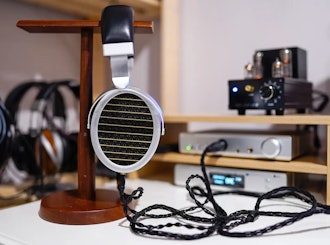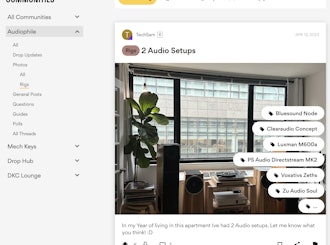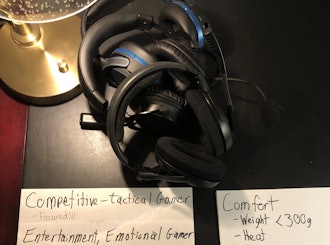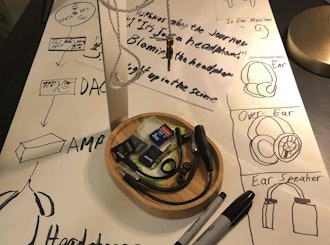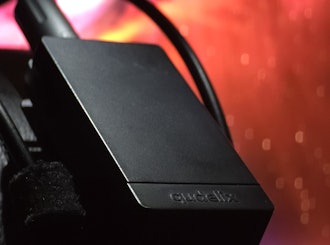Click to view our Accessibility Statement or contact us with accessibility-related questions
























Is Bluetooth as Good as a Wired Connection?
Back when I visited CanJam NYC in 2016, I got to talking to the two founding members of Bluewave, and had an extended conversation and demo of their soon-to-release Bluetooth receiver/DAC/Amp, the GET. They argued that the quality of Bluetooth has reached a point where the internal components used had a bigger impact on the final sound quality than the fact that it was wireless, and their device would have better sound quality than the headphone jack in my smartphone. I thought this was an interesting challenge, and I had to research and rethink my perspective on Bluetooth audio.
You see, Bluetooth is a digital transmission, so it bypasses capacitance and EMI factors of headphone cables. Then, the Bluetooth receiver must then use a DSP (like a computer) to decode and decompress the transmission, a Digital to Analog Converter (DAC) and an Amplifier before outputting to the headphone transducer (speaker). When you buy a Bluetooth receiver, you’re also buying a DAC and an amp! With a made-for-Audio Bluetooth receiver, all the components inside have the opportunity to be built to higher spec than what is included in a smartphone or laptop.
The current state of Bluetooth audio is different than most people realize, and better than the stigma. There are advantages and disadvantages, besides not having a cord coming from your pocket.
Shortlist of +Pros and -Cons
+High res Bluetooth codecs (aptX HD, LDAC, LHDC) don’t have to re-compress Spotify Premium streams and have little to no compression added to FLAC streams close to CD quality (TIDAL HiFi, Qobuz high res).
+Bluetooth can extend further than most wires included with headphones, and also pass through thin walls without drilling a hole.
+Wires (especially longer wires) can affect the sound reproduction, but Bluetooth is transmitted digitally with error correction, and the BT receiver, DSP, DAC, Amp, and headphone transducer/speaker are either point-to-point soldered together or have very short signal paths.
+The DAC and Amp can also be tailored to match the headphone.
The downsides:
-Latency is reduced but still present.
-While Bluetooth range is pretty long, sometimes it can be blocked by walls or subject to interference when many Bluetooth signals are blasting nearby.
-Bluetooth headsets are limited by battery life, and the source (I.E. your phone) drains battery a little faster than a wired connection.
-A battery and other electronics in a headphone/headset mean more weight and bulk, which is often the reason behind neckbands or short battery life in True Wireless IEMs.
-Bluetooth audio can only be sent to one device, so no silent discos.
Bluetooth 5 and 5.1
Back when the Sony Xperia XZ Premium, iPhone 8/X, and Samsung Galaxy S8 were coming out with Bluetooth 5 in 2017, I got really excited about its increased power that could be used for range or data transmission rate. Figures like 2 Mbit/s burst transmission at short range or lowering the transmission rate to achieve over 300 feet of range boggled my mind, and had me thinking Bluetooth could become an alternative for WiFi in some cases. However, I later learned that those high figures were only possible with two “class 1” Bluetooth devices (both transmitter and receiver), and that in a more practical sense these Bluetooth codecs would mostly affect advertising and “Internet of Things” devices. Bluetooth audio would remain mostly the same as the 4.2 era, with about the same 30 foot range and the audio bitrate determined by the Bluetooth codec.
Codec Conundrums
Want to stream Spotify Premium, Apple Music, or a social service like YouTube and Facebook? Bluetooth that supports AAC or aptX will be enough to transmit the audio without further compression. Want to stream TIDAL or Qobuz Hi Res tiers of service? Qualcomm’s AptX HD, Sony’s LDAC, and Savitech’s LHDC can carry higher bitrates, and at short range in a good environment LDAC and LHDC can “carry” most of a CD-quality FLAC amount of data, but they’ll probably need to compress the data just a little. AptX Low Latency and similar codecs interest me the most for gaming, because lag is always our enemy!
Wireless Options
We’re seeing many releases now for Bluetooth. There are the traditional on-ear/over ear headphones, neckband IEMs, what I’ll call neck-wire IEMs, and True Wireless IEMs, as well as Bluetooth Receivers.
On/Over-ear headphones were the first type of Bluetooth Headphones, but these days some manufacturers are beginning to experiment with Hi-Res Bluetooth headphones that are meant for serious listening.
Accessory neckbands that add Bluetooth to existing IEM models or are hardwired to rereleases of earpiece capsules (for example, the IE 80S BT or the CX 7.00bt from Sennheiser) add flexibility, and put the weight of the battery, remote controls, and electronics on your neck instead of hanging on your ear, and they often use the extra space for larger batteries and sometimes dual microphones for noise cancellation. Neckbands are also an easy solution for how to share one Bluetooth connection between the left and right channels. Neck-Wire Bluetooth IEMs, such as the Sennheiser Momentum Free, have an in-line “pod” hanging from the ear with the electronics, a shorter battery life, but they are flexible and easier to fold up into a small pocket-sized case.
True Wireless IEMs deserve their own paragraph here! They may be the newest, hottest thing, but they’re tricky to do well. First thing people realize is the earpiece battery life is shorter than we’re used to, and almost all of these come with a “charging case” that is essentially a battery bank... but I only use IEMs for one or two hours at a time before needing a break, and I recommend thinking about how long a typical IEM session comfortably lasts. These are intended as everyday carry devices, so charging at night or after long-term storage is to be expected. Second, how to sync and share audio between the left and right ear pieces? I’ve had different engineers tell me that basically the best way to go is NFMI, or Near Field Magnetic Induction. Bluetooth has difficulty transmitting through water or dense materials – like our bodies – so magnetic induction is better because it can go through or around the head to keep the earpieces in sync. One earpiece has to be the “Master,” so that’s why usually there’s one earpiece that drains battery faster than the other side. Thirdly, they’re a bit heavier than wired IEMs.
Bluetooth Receiver devices are a new category, and shouldn’t be overlooked. You could also call them a wireless adapter, because what you do is plug regular wired headphones or IEMs into this (usually little) device, and the device does everything from streaming the audio to powering your headphones. That way, if you already have a headphone with a sound you like, you can have your favorite flavor and get it in Wireless too. Some examples from this category are the Bluewave GET, Radsone ES100, FiiO BTR3, iFi XCan, and many more units from companies like Astell and Kern, Creative Labs, Beyerdynamic, etc. There are also a number of Digital Audio Players (DAPs) that also have a 2-way Bluetooth function, so they can also act as wireless adapters in addition to being their own source of audio. Some examples of 2-way Bluetooth DAPs include the newer Sony Walkmans (Walkmen?), Hiby DAPs, FiiO DAPs, Shanling, Cayin, Acoustic Research, and more.
DLNA servers or Airplay over WiFi are still going to be our uncompressed digital wireless solutions for now, and RF Wireless is still going to be the lag-free solution that should appeal most to gamers, though RF options are fewer now than they once were.
Wireless and Gamers
Well, the biggest issue I’ve seen is lag. Bluetooth receivers have work to do before they can playback sound. Furthermore, if Chat with a microphone channel is meant to send audio back to the gaming device, that cuts into the total available bandwidth and only certain audio codecs support an audio return channel. Games like PUBG Mobile switch to audio codecs usually meant for phone calls, which leads to noticeable drops in the game audio quality. That’s why Turtle Beach, Astro, and other gaming headset makers have often made “headset and base” combo units, using RF instead of Bluetooth. Sennheiser’s new GSP 670 and GSP 370 use a USB dongle that acts as an 2.4 GHz RF transmitter instead of using a big base station, and the GSP 670 only has Bluetooth 5 as a secondary transmission option for mobile devices. Lastly, wireless bandwidth, whether Bluetooth or RF, is usually only enough for stereo playback... so if you want a true binaural “Surround Sound” mix, the processing has to be done before transmission, otherwise the two channels of information are only really suitable for emulating two speakers in front of you.
However, I see some hope! Again, AptX LL helps a lot with the latency issue. And I don’t know what codec is supported with Call of Duty Mobile on my iPad, but I have a certain Planar Magnetic Bluetooth Gaming headphone that performs much better in the new game than PUBG, essentially with playable latency and much better audio quality!
Conclusion
Personally, I’ve observed huge advancements in Bluetooth audio over the years. Much of the old stigmas have been addressed, and I’m excited to see where the future takes us.
Bio: I am Evshrug here, Head-Fi, Instagram, Twitter, Twitch, and on YouTube. I got into audio because I wanted a more immersive gaming experience, and I write because I want to help people and share what I learn. Currently, I consult for a few audio companies including Sennheiser and Dekoni, but my statements don’t represent those companies (and their level of knowledge). Learning is always a work in progress, so feel free to add sources and help out :)
A link to all my blog posts: http://www.head-fi.org/t/646786/evshrugs-if-i-knew-then-what-i-know-now-discussion-journal
(Edited)

search
close
Sort by: Newest
keyboard_arrow_down
SuperShibe
29
Jan 27, 2022
This is a lot of good information, but I'm still sticking to wires. Personally, I don't need any cables long enough to introduce noticeable noise or distortion. Bluetooth also costs more, and the best products don't necessarily offer bluetooth, so I don't feel obligated to limit myself to it. Not to mention that converting the bluetooth signal to digital is a completely unneeded potential point of distortion, or that I would need to manage batteries and/or recharge the device.
I don't have a lot of high resolution music yet, and I'm not opposed to using bluetooth entirely either (I use it with my car and it still sounds great, but I didn't pay any extra to put it in and my phone's dac sucks anyways)
Anyways, thanks for sharing information with the community. Cheers!

Evshrug
3773
Community
Jan 27, 2022
SuperShibeYeah! I wrote this years ago, after realizing Bluetooth had way more potential than I thought.
I still bemoan the loss of headphone jacks on smartphones, the marketing that wired is now either “antiquated” or a “pro/premium feature” that you have to pay extra for (seriously, there isn’t a good reason for the headphone jack to have been removed from the new Mac mini). I still know wired has less latency when I’m gaming. I also think using Bluetooth with analog playback sources, like Vinyl, completely misses the point of both Bluetooth and using an analog source.
However, Bluetooth is currently really nice for connecting to sources without adapters, frayed cables, snags, tangles, and knots, etc. Looking at my car’s radio, desktop computer, video streamer, smart TV, smartwatch, tablet, and even my smartphone, it’s looking like more devices have Bluetooth than headphone jacks. So, thank goodness we’ve progressed to the point where Wireless audio doesn’t HAVE to sound robotic and fatiguing, and there are new wireless codecs and faster processors that almost clear up gaming latency.
I wrote the bluetooth article here several years ago, but now as of early December. I started working with a new headphone company with a vetern acoustic engineer of the headphone industry in late November 2021. And guess what? Our first product is a pair of true wireless in-ear headphones, and I happen to think they help push the boundaries of wireless sound quality in all the ways I mentioned above :)
l33tplaya
1
May 20, 2021
Bandwidth? This seems to have been completely ignored. Best Bluetooth can't do even full CD quality. So I think you were misled by marketing folks re quality of components being *more* important. Maybe more important compared to existing BT implementations, but not compared to a very good wired set.

Evshrug
3773
Community
May 24, 2021
l33tplayaWhile it’s true that currently LDAC and LHDC codecs are limited to about 900 kbps, bluetooth 5 can support up to 2 mbps. As a formerly common baseline, the low loss CD format AIFF uses 1411 kbps... but compression techniques like FLAC have greatly advanced since the days of optical discs which are fading fast in the rear view mirror (https://pitchfork.com/news/vinyl-outsells-cds-for-the-first-time-in-decades/amp/). Also, with most music consumed these days in a streaming format well within existing Bluetooth codec’s kbps envelope, a wired or wireless connection would make little difference.
But that’s not even the biggest point... you have to consider the connections as part of a system and a chain of components to supply the audio. No, Bluetooth will not surpass the maximum quality possible with wired: I would happily take my $1400 headphones + $500 wire + $2400 DAC/amp + $12 decent USB cable + HDTracks hi res files over any current Bluetooth setup on the market when at my office desk... but not everyone’s setup will be like that, nor will that always be a setup that can be used in certain situations. A Bluetooth headset (or a Bluetooth adapter like the Earstudio ES100, Bluewave GET, FiiO BTR5 or Q5S, etc) should also be considered as a DAC/Amp component too. A wired headphone connected to a built-in headphone jack on a laptop could easily have its sound quality surpassed by a Bluetooth headset with low internal noise, a good DAC filter and programming, and an amp with low distortion and good power. A wired connection can vary widely depending on the components further up the signal chain, while a Bluetooth headset will have had its components carefully selected to have good synergy with the headphone.
So, yes, the maximum possible quality goes to a wired connection. However, so many other components or compression levels that bottleneck quality more than Bluetooth does in many (most???) typical setups. I’m far from against wired connections, and I sincerely wish they were still a common option on smartphones and I totally intend to set up a wired connection for my PS5 when it arrives in the mail (tomorrow!!!). However, Bluetooth is far more advanced from its early days and continues to develop, and is at a point now where we review our stigmas.
Lastly, I’m not doing marketing by saying this... I don’t have any connections to FiiO, Bluewave, or Earstudio other than being a customer of a few of their products and talking to them at audio shows. This is just an opinion piece that presents the evidence and experiences I’ve had, and a bit of a prediction of the future.

newbee
28
Feb 22, 2021
Hi Evshrug, thanks for the info. Thanks for being one of those people who like to learn,be curious and share what you have attained. We are all better off, if we in turn take the time to do the same. Be safe and carry on. Cheers Leonard.

Evshrug
3773
Community
Apr 5, 2020
mrkb34And thank you for the thumbs up! Sometimes it’s good for me to coalesce my thoughts into one article. It helps other people and I can link to it instead of retyping parts of it as a response to someone.
Plus, as much as I want to help and explain to people here, I’m also trying to convince Mfrs as well... the tools for HiFi bluetooth are here and improving, and I’d like to see more efforts towards HiFi BT headphones. The more that people like you make reference to and share a write-up like this, the more likely mfrs will see it.
(Edited)

Evshrug
3773
Community
Oct 24, 2019
KoltaiPGlad I could help! Feel free to bookmark this, and share the link if you see anyone else asking about Bluetooth :)

Evshrug
3773
Community
Oct 17, 2019
RayFOn one hand, it’s a closed system, so it could be balanced from the DAC through the amp (and cables), so it would be easy to do.
On the other hand, it’s such a short cable run, and you basically could get all the same benefits from other parts of the design.
So, it’s not going to make much of a difference, but on the other hand, if it’s basically the same price and a good sounding system overall, why not?
(Edited)

Evshrug
3773
Community
Feb 12, 2020
RayFTo add to this response, a practical example: My Sony Walkman ZX300A has 50 mW per channel (@32 Ω) on the single-ended output, while the balanced Pentaconn output offers 200 mW (@32 Ω) per channel. The SE output is great with IEMs, plenty of power without too much gain and no background hiss with the IEMs I’ve tried, while the BAL output sounds wonderful with my HD 660 S full-sized headphone.
If you think about it, Pretty much all speakers are wired in Balanced. The longer the cable run, the more apparent the benefits of Balanced become. You can find research on websites that actually shows audio engineering formulas expressing the capacitance (or was it resistance? I forget off the top of my head) of wires in relation to the length of the wire. Most headphone cables are short, but the differences should be audible for those 3M “listening chair” setups.
Sony COULD have shortened the battery life and just made the SE output more powerful, and then it might have sounded very close to the sound from the BAL output when on-the-go (with short cable lengths). The volume for sensitive headphones would also have to be kept pretty low. In this case, having both the SE and Balanced ports gives me a nice choice for use with IEMs/portable headphones and full-size “home” headphones.

Evshrug
3773
Community
Feb 12, 2020
Oh, I don’t think I ever explicitly said it, but since the Sony ZX300A can act as a Bluetooth receiver (with some great high-quality codecs, and a good amp), I basically use this instead of the Radsone or Bluewave these days. Sounds really good!

ElectronicVices
2937
Feb 17, 2020
EvshrugI do greatly enjoy the two way BT of more modern DAP's... I picked up a FiiO M6 a while back (almost exclusively for BT use) and love it. Not the fastest UI but given it's size and cost it's a hell of a combo. I use it primarily to feed BT speakers and as a BT receiver from my phone when not carrying the Radsone.
Related Posts

Evshrug
Audiophile 101: Essential Gear Overview
Image credit @zhugunic https://drop.com/talk/67372/gl-2-k Do I need an amp? What are these acronyms like DAC, DSP, or DSD? What even are all the components that make up an audio chain? Let’s take a beginner’s look at the core, essential building blocks of a digital audio chain, and lay it plain what each piece does. We can cover the major pieces separately, but I’ll still include a few tips to optimize playback here. Please hit the little bookmark button and feel free to check and share this guide whenever you need a reference! For people who need a visual and audible explanation, or are worried it would take too long to get a working knowledge of the audio chain, here is my YouTube video on this subject that is just 7 minutes long! I like writing though, so let’s get started with an overview, then break it down into what each piece does and how an upgrade would benefit the final sound quality. Signal Path Image credit @SpeleoFool https://drop...
Mar 22, 2023

HoffmanMyster
New Feature—Product Tagging in Photos (+ Giveaway! - Audio Rigs Edition)
Ahoy, audiophiles! Hot on the heels of the launch event for the mech keys community, we are kicking off the Audiophile Rigs product tagging launch event (with a bonus giveaway for those who participate!). Check out all the Rigs submissions thus far! Audiophile Rigs What’s this about a giveaway? More details can be found at the end! The short version: we will be giving away $100 Drop Rewards credit to one lucky winner (randomly selected) from all participating users who contribute and tag their Audiophile photos using the "Rigs" flair! In order to be eligible for giveaway prizes, your photo must include at least two tagged items (not required to be Drop products—see Tagging Non-Drop Products below). Post must be made in the first two weeks (by 2023-05-10 11:59PM PT) in order to be entered. What is Product Tagging in Photos? Product tagging allows you to tag any products in a Photo post—both those found on Drop currently, as well as write-ins that will be manually approved and...
Apr 26, 2023

dekoni
Introducing Dekoni University
Dekoni Audio is excited to introduce our new Dekoni University video education series. Check back frequently to see our latest videos.
Aug 10, 2021

krist0f
DAC/AMP choice - please help
OK... I am going thru forums, reading and watching reviews for DAC/AMP combo for my pc and... seriously i do not know which one to choose. Here is my 'wish list'... maybe you can help... Main goal is to... like everybody i guess: listen to music / watch movies / gaming. Gaming is priority. I am not audiophile (sorry). But I do appreciate good sound quality. Wish List: will not 'break the bank' - preferable under $200... I would prefer it to have mic input but it is not a 'must' requirement. I would prefer it to be 'external' device. Not a must though. Need controls on the desk though. I would prefer it to work 'driverless'. So... hardware-based. I would like it to have some kind of hardware equalizer. I would like to be able to connect (computer) speakers and headphones the same time it does not need to be 5.1/7.1 etc. I prefer good stereo over these systems. Does anything like this exist? Closest to all checkmarks is Sennheiser GSX1000... i guess... not the newest technology...
Jan 5, 2021

Evshrug
Thoughts: The BEST Gaming Headphone for All Time?
Pairing up a gamer with the right headphone is a bit like playing matchmaker! In this video, linked at the end, I boil down over 10 years of community advice into 3 Personality types: • Competitive • Entertainment • Immersion I share a few keywords to look for, as well as some software and settings suggestions. I think everyone has a little bit of each type in them, but which type is dominant for you? Thanks to the sponsor of this video: DekoniAudio.com Dekoni is a headphone accessories company, unique for providing frequency response graphs on their website so you know what effect their various pad options will have. Thanks also to Drop for giving me permission to share here. I hope it helps everyone! The video: https://youtu.be/42SRsSlIj-c
Sep 29, 2020

Evshrug
Launch of the EvShrug Audio Guides!
Hello everyone! I’ve been here in Drop/Massdrop for a few years, also on Head-Fi since 2008, and I’ve seen a few common questions and gaps in knowledge over the years. So, to try answering them so that I (or you) can simply link a video when a common question comes up, I “rebooted” my YouTube channel with new videos to serve as a guide for new and intermediate personal audio enthusiasts! Thanks for accepting my amateur production with a “shrug” and a subscribe, I’ll try to upload 1-2 videos a week and add them here as well. Go ahead and leave audio questions you think others would also want answered! YouTube Playlist: https://www.youtube.com/playlist?list=PL4bc2SQk0h2TrE0K07t2WI5by66ArtDAb
Sep 12, 2020
Trending Posts in Audiophile

harrykane01
World Of Shanik
The World of Shanik, known for its fusion of culinary excellence and elegant design, now offers a diverse range of products to enhance your lifestyle. From the exquisite turntable cheese board, perfect for entertaining guests with style, to the nightstand organizer wood, keeping your essentials neatly arranged, to the custom tequila shot glasses that add a personal touch to any gathering, Shanik continues to innovate in both form and function. Since its inception as a celebration of good food, good people, and sophisticated design, Shanik has evolved into a trusted destination for those who appreciate quality craftsmanship and tasteful living.
Apr 25, 2024

robbertwilson
Shop Premium Women Golf Shirts at ApparelnBags
Be the trendsetter on the golf course with our stylish collection of custom polo shirts for women. Whether you're swinging your way to victory or simply want to rock that sporty chic look, our polo shirts for women are here to make you stand out. Moreover, we understand that style and quality go hand in hand. That's why, from golf shirts for women to long sleeve polo shirts for women , we handpick the best products to ensure you experience comfort and durability. Also, our women polo shirts offer the perfect blend of style and functionality, so you can focus on your game without compromising style. So, grab your favorite polos today. Remember, it's not just a game; it's a lifestyle, and our polos will help you ace both!
Apr 25, 2024

SsButerbal
Ringing in PC38X's
I recently got this headset, and wow is it good. My only issue is when certain people talk on discord, I can hear a really high pitched ringing. I fiddled with a bunch of settings, computer audio and discord, and nothing seems to solve the issue. It is primarily if not all in my right ear only. Is there something wrong with my headset, or was that ringing always there I can just hear it cause the headset is THAT good? I haven't had any issues with any other application, though I have yet to test if I can hear the ringing on a different version of discord, say on my xbox instead of my pc. Only other issue I've had is occasional static, but I can't tell if it's from the headset or the show/game/etc.
Apr 24, 2024
itsamepe
Sennheiser PC37X randomly goes bad after disconnecting the cable ?
Greetings, Yesterday I was using my headset like normal with my macbook, just listening to music and on a call with people like usual, and the headset was perfectly fine. The stock wire that came with the headset is extremely long and yesterday it annoyed me very much that it kept getting tangled with itself, so I decided to see if the cable is replaceable. I pulled out the cable from the headset and saw the adapter, and looked online for a replacement. Upon plugging it back in, the audio sounded extremely muffled and washed out. Im not sure what I did wrong to make it mess up like that as I've always taken good care of it, ive had it for about 2 years and its always just been chilling on my desk, but anywho I thought the cable just went bad and ordered a replacement. The replacement came, and the issue is still persistant, so I am not sure what the issue is I've tried multiple different headsets and the issue is not with the port, and I also tried it with my windows laptop and...
Apr 23, 2024

MrChiSox
Big changes coming to my tiny little music room, I've recently purchased a new stack. Currently figuring out where to locate it all and ordering up the necessary cables, it won't be too long before I'm up and running. I am now the proud owner of a brand new stack. It's a European brand called Earmen. Amp, DAC, Streamer & Linear Power Supply. It won't be long!
https://www.youtube.com/watch?v=MB15yM4UptQ
Apr 23, 2024

Briankan
Recommendation for my next headphone set? I have Koss 95x
Hey all, What would you recommend I get next and why? I have Koss ESP-95x electrostatic massdrop headphones. These are my first and only audiophile set. I love them. I think my only real requirements is $500 or less for the headphones and that they have a little more low end. I don’t need thump but these are really light on lows…but the experience is still awesome. Also any recommendations on an amp? I only have my electrostatic thingy. I am using the Topping D50 DAC. thx!!
Apr 22, 2024

Simthaniel
Rigs
Modded headphones with qudelix at the core
When I received the Qudelix 5K, I had already modified a pair of Superlux HD-681 headphones. I previously soldered my own balanced connections to the drivers, providing multiple ways to connect and...
Apr 14, 2024

